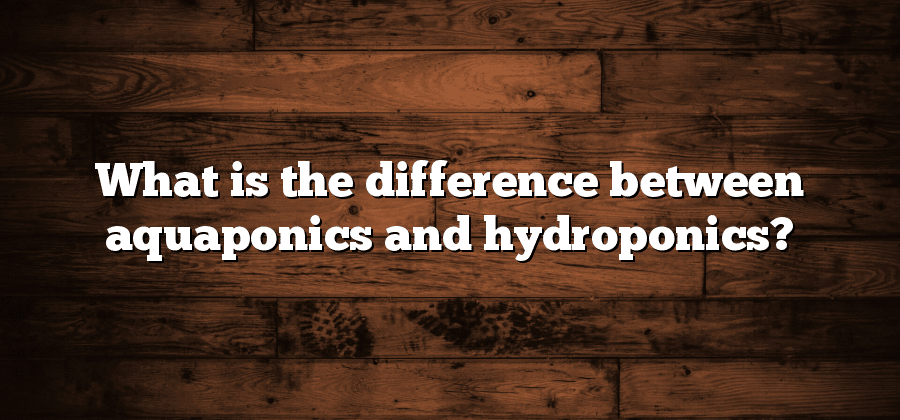Understanding Aquaponics
Aquaponics, a symbiotic system that combines aquaculture and hydroponics, is quickly gaining popularity among hobbyists and commercial growers alike. This innovative method of cultivation offers a sustainable and efficient way to grow plants and rear fish simultaneously. At its core, aquaponics harnesses the natural balance between fish and plants, creating a mutually beneficial environment that maximizes growth and minimizes waste.
In an aquaponic system, fish waste serves as a nutrient-rich fertilizer for the plants, promoting their growth and vitality. The plants, in turn, filter the water in which the fish reside, creating a clean and oxygen-rich environment for their aquatic counterparts. This intricately linked cycle eliminates the need for conventional soil-based farming methods and chemical fertilizers, making aquaponics an environmentally friendly alternative. Whether you are an avid gardener looking for a new challenge or a sustainable farming enthusiast, understanding the fundamentals of aquaponics is key to harnessing its tremendous potential.
The Basics of Hydroponics
Hydroponics is a modern method of growing plants in a soilless environment. In this technique, plants are grown in water-based solutions enriched with essential nutrients. The absence of soil eliminates the risk of soil-borne diseases and pests, offering a clean and controlled growth environment. Hydroponics also allows for better water and nutrient management, resulting in more efficient plant growth.
One of the key benefits of hydroponics is its ability to maximize limited space. By eliminating the need for soil, hydroponic systems can be set up in small areas, making it ideal for urban gardening or indoor cultivation. Additionally, because plants receive a direct supply of nutrients, they can grow faster and yield higher crop production compared to traditional soil-based farming. This makes hydroponics a viable solution for sustainable food production in densely populated areas or regions with limited arable land.
Cultivating Plants in Aquaponics
One of the main benefits of cultivating plants in aquaponics is the ability to grow a wide variety of plants throughout the year. With this innovative system, plants are provided with a constant supply of nutrient-rich water, creating ideal growing conditions. Furthermore, the absence of soil eliminates the need for traditional gardening practices such as weeding and tilling. This makes aquaponics a more efficient and sustainable option for plant cultivation.
Another advantage of cultivating plants in aquaponics is the ability to control the growing environment. In traditional soil-based gardening, factors such as weather and soil quality can greatly impact plant growth. However, in aquaponics, you have the power to regulate the temperature, pH levels, and nutrient concentrations in the water, ensuring optimal growing conditions for the plants. This level of control allows for year-round cultivation of crops and higher yields compared to traditional methods.
Growing in Hydroponic Systems
Hydroponic systems offer a controlled and efficient way to cultivate plants without the use of soil. This method relies on a nutrient-rich water solution to provide plants with the essential elements they need for healthy growth. One of the key benefits of growing in hydroponic systems is the ability to customize the environment to meet the specific requirements of different plants. By carefully monitoring pH levels, nutrient concentrations, and lighting, growers can create the optimal conditions for plants to thrive.
In hydroponics, plants are typically grown in containers or troughs that hold the water solution. The roots of the plants are suspended in the solution, allowing them to directly absorb the nutrients they need. This direct nutrient uptake results in faster growth and higher yields compared to traditional soil-based cultivation. Another advantage of hydroponics is the efficient use of resources such as water and fertilizers. Because the water is recirculated in the system, there is minimal water wastage, making it a more sustainable and environmentally friendly method of cultivation.
Nurturing Fish in Aquaponics
To ensure the successful nurturing of fish in an aquaponics system, it is crucial to prioritize their well-being and provide them with optimal conditions. Proper care and attention are essential for maintaining healthy fish and achieving a thriving aquaponic ecosystem. One important aspect to consider is the water quality. Regular testing of water parameters such as pH levels, ammonia, nitrite, and nitrate is necessary to ensure the optimal health of the fish. Any fluctuations in these parameters should be promptly addressed through appropriate measures, such as adjusting the pH or adding beneficial bacteria to regulate the ammonia and nitrate levels.
Additionally, providing adequate nutrition is vital for the growth and development of the fish. A well-balanced diet specifically formulated for the species being cultivated should be provided to meet their nutritional requirements. Feeding regimens should be carefully followed, taking into account the size and age of the fish, as well as any special dietary needs. Overfeeding should be avoided, as excess food can lead to water pollution and negatively impact the overall health of the fish. Regular monitoring of the fish’s feeding habits and adjusting the amount of food accordingly will help maintain a healthy and sustainable aquaponics system.






